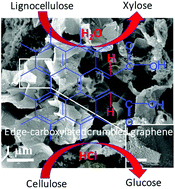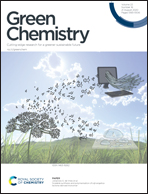Dry ice-mediated rational synthesis of edge-carboxylated crumpled graphene nanosheets for selective and prompt hydrolysis of cellulose and eucalyptus lignocellulose under ambient reaction conditions†
Abstract
Edge-selectively carboxylated graphene (ECG) crumpled nanosheets are of great importance in potential applications; however, their catalytic activity towards biomass hydrolysis is not yet highlighted. Herein, we rationally designed two-dimensional ECG nanosheets with tunable COOH content via the ball-milling of graphite with dry ice as an efficient catalyst for selective hydrolysis of cellulose and lignocellulose. The fabrication method is simple, one pot, productive (up to gram-scale), green (no hazardous oxidizing agents), and allows selective edge functionalization without damaging the graphitic basal plane. The as-formed ECG are water-dispersable and self-exfoliated two-dimensional crumpled nanosheets with a high surface area (94.1 m2 g−1) and abundant COOH (26.45%) at the edges. These peculiar structural and compositional merits of ECG lead to the hydrolysis of cellulose to glucose in high yield (87%) alongside the hydrolysis of eucalyptus to xylose (89%) and glucose (65%) within 20 min at 180 °C in the presence of HCl (120 ppm). Meanwhile, ECG hydrolyzed eucalyptus into xylose (98%) in water, owing to its layered structure, hydrophilicity, and synergistic effect. The catalytic performance of the ECG catalyst was benchmarked as a function of COOH content relative to pristine graphite and HCl. The hydrolysis mechanism and kinetics of ECG over cellulose were deciphered via various reaction experiments, conditions, and pretreatments. The present study may open new horizons towards the utilization of ECG in the hydrolysis of biomass.



 Please wait while we load your content...
Please wait while we load your content...